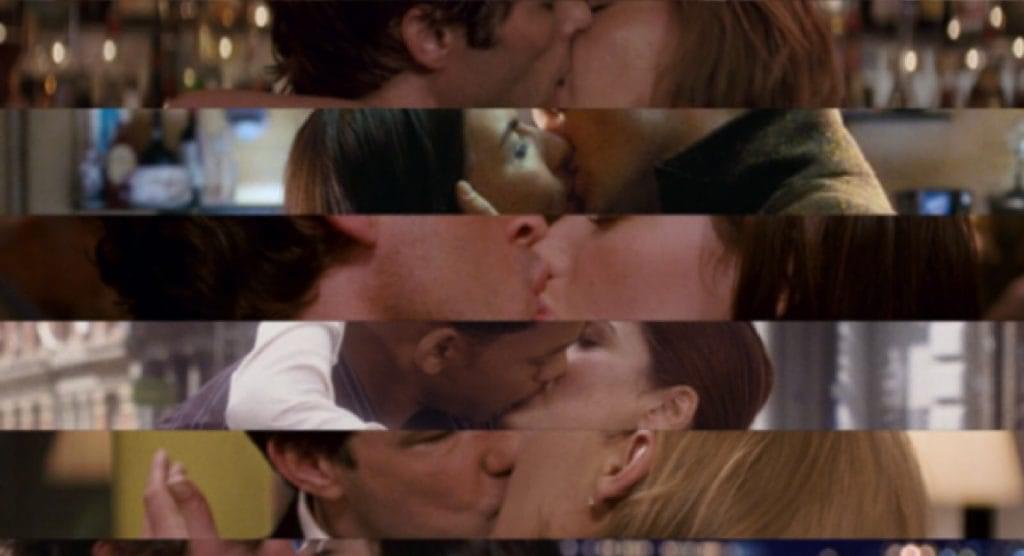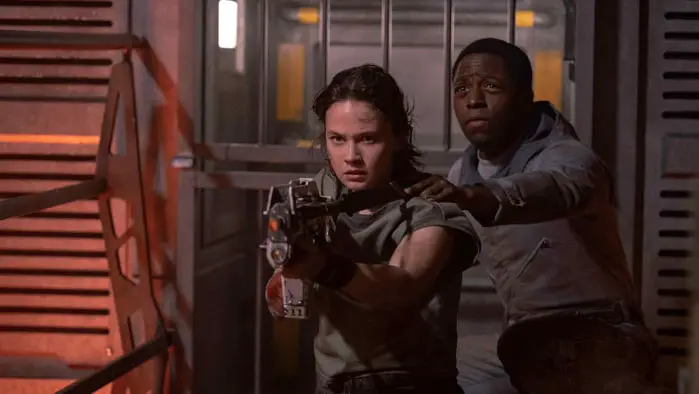
True addicts of contemporary B-Movies will genuflect at the mention of Tim Ritter’s name. As the creative force behind contemporary horror cult classics including the “Truth or Dare?” trilogy or the grisly features “Creep” and “Killing Spree,” Ritter has been terrifying and entertaining audiences with his intense, envelope-pushing approach to filmmaking that liberally mixes pulse-banging suspense with unapologetic violence. If Alfred Hitchcock and Herschell Gordon Lewis had their genes spliced together, the result would easily be Tim Ritter.
Born on a Friday the 13th back in 1967, Ritter was still in high school when he scripted, directed and edited his first feature, a 1984 Super 8mm production called “Day of the Reaper.” Shrewdly recognizing the potential of the then-nascent direct-to-video market, Ritter self-distributed his production to video wholesalers and, in the process, helped lay the groundwork for what is now one of the most important facets of the home video market. He followed up “Day of the Reaper” by co-directing the video anthology “Twisted Illusions” (1985) and wrote and directed (albeit without director credit) the first installment of the “Truth or Dare?” series that introduced one of the most indefatigable serial killers to slash his away across the screen, The Coppermasked Madman.
Throughout the 1980s and 1990s, Ritter helmed his own productions and also served a variety of function on other works including stints as writer, editor, second unit director, narrator, and even “creative consultant.” In 1995, he directed “Creep,” a horrifying adventure following the crime trail of sibling serial killers. Even in the no-holds-barred world of B-Movie filmmaking, “Creep” cut more than a few nerves and 25 minutes of footage was excised before the film could hit the video stores; a restored version was subsequently released a few years later. In 1999, Ritter achieved a personal best with his wicked “Dirty Cop, No Donut.” This wild, sicko parody of police-reality TV shows focused its cinema verite camera on a lunatic cop (named Officer Friendly!) barreling through an all-night rampage of bullying and brutality. The film earned Ritter his best reviews, including praise from the influential Amazing World of Cult Movies which cited the film as “everything an indie cult film should be.” A sequel, “Dirty Cop, No Donut 2: I am a Pig” is rolling out this month with Officer Friendly on the loose for more miscreant shenanigans.
This year finds Ritter in a brand new challenge: he is in charge of Sub Rosa Midwest, a production division of the B-Movie distributor Sub Rosa Studios (www.b-movie.com). Ritter’s mission is to encourage the production of new B-Movies and the acquisition of recently completed features from filmmakers within the Central Time Zone. He is also stepping away from the cameras to try his hand at literary pursuits.
Film Threat caught up with the Kentucky-based Ritter to discuss his unique contributions to the woolly world of B-Movies.
In your professional opinion, what is required to create a successful horror film? And do most horror films succeed or fail in eliciting the right degree of thrills and chills?
I think the key to making a successful horror film is having people behind it that are passionate about the genre and the project they are making. If someone is doing it just to make money or as just a “job for hire,” they are less likely to come up with something that connects with the hardcore fan and delivers the goods. And even if you have all of that behind a given project, sometimes things just don’t come out as you might have liked because of monetary restrictions or other extraneous factors. But examples where the synergy of the creative people behind it really worked and paid off include “Henry: Portrait of a Serial Killer,” ” Last House on the Left,” “The Night of the Living Dead,” “The Texas Chainsaw Massacre” and, more recently, “Scream.” Those are some of my personal favorites. Most of these are independent films that were made outside the studio system and due to everyone’s inexperience, passion, and desire to work together, the movies paid off. “Scream” is an example of a passionate script that was written by a fan and TV actors really wanting to branch out with Wes Craven putting one hundred percent into the production. You could tell he was really inspired to make that movie, unlike “Scream 3,” where everything seemed tired, worn out, and strictly done for the cash. That’s why most mainstream horror films fall short in the chills and thrills area and only occasionally does something really smart and wicked get through the pipeline. They are being made by people who don’t necessarily love the genre, people who constantly tell Fangoria that, “oh, this isn’t a horror film, it’s really a thriller” or whatever.
What films and filmmakers inspired you to pursue the horror genre?
Craven, Cunningham, Carpenter, Romero, Cronenberg, Waters…all the well-respected guys that were in their prime when I was growing up in the late seventies and early eighties. The films include all their classic works that are still revered today, like “Last House,” “Friday the 13th,” “Halloween,” “Dawn of the Dead,” “Scanners,” “Pink Flamingos.” And of course there were people like Sam Raimi and Tobe Hooper that zipped through with a movie or two that are unforgettable cult classics. Other influences were H.G. Lewis, Savini, “Maniac,” Stephen King, and Fangoria Magazine!
Your first feature, “Day of the Reaper” (1984), was shot in Super 8mm. Your subsequent films have been shot in 16mm and a slew of video formats. From a production standpoint, which is the most satisfactory format to shoot a film in?
To me it really doesn’t matter. Telling the story and getting it out there to an audience is the important thing. From a production standpoint, video is the most satisfactory format to shoot in due to the economical costs and being able to be experimental with what you do. The immediate dailies are also nice to have, too. As far as decent distribution, as always, film cannot be beat. Super 16mm and 35mm still make the most impact in terms of sales and being taken seriously, despite the success of “The Blair Witch Project.”
You self-distributed “Day of the Reaper” to the video wholesalers at a time when the direct-to-video market was beginning to take root. What is your opinion of today’s video distribution channels when compared to when you first came into the business?
It’s still similar. You really have to sell what you’ve got, and there’s always been competition. Packaging and content still count. Today it’s much harder to get your work into video rental stores because a lot of the mom and pop stores are gone and you have to deal with chains that have strict guidelines and policies on what they buy. Even the mom and pop stores are very picky on what they buy, there’s a lot of selection and demographics to consider. But independents still have a chance, and places like Blockbuster and Hollywood Video support indies. Also, the sell-through and DVD markets have really helped out independent sales as places like Best Buy, Sam Goody, and Circuit City carry a lot of independent product. There’s definitely still a demand for B-movies.
Your “Truth or Dare?” trilogy created the ultimate serial killer in the guise of The Coppermasked Madman. What creative energies were responsible for shaping the warped personality of The Coppermasked Madman…and will he be back for a fourth go-round?
At this time, there’s no plans for a fourth installment. But you never know if the right story hits me! So I wouldn’t ever completely rule it out because I’m such a fan of Jason and those “Friday the 13th” flicks. The creative energies behind the Coppermasked Madman were my enthusiasm for those Jason flicks and wanting to emulate those classics. Also at the time, I had been smitten with a couple of females that essentially left me heartbroken, and those negative emotions got channeled into the whole ‘truth or dare’ thing. I realized that quite a bit of the violence that happens in America has to do with jealousy and domestic trouble, so it seemed to be a great theme to explore at the time. As the movies went along, society proved I was right with the O.J. thing and other similar high profile events. So we tried to comment on all that with the last episode, which I collaborated on with Ron Bonk and Kevin Lindenmuth.
I look back at all of the movies and see that they are seriously flawed, just like me! But they all have moments in them that I’m proud of and that slasher fans still enjoy. That’s what counts. There were a lot of kids that rented “Truth or Dare?”, watching it at slumber parties late at night when it first came out! It’s very cool to meet them now and hear the great memories they had being scared by that movie when they were very young. It’s like a campfire tale!
When “Creep” was first released in 1995, 25 minutes were cut from your original concept of the film. This footage was subsequently restored for its video re-release in 1999. What scenes were cut and why? And how have audiences reacted to the restoration of nearly a half-hour’s worth of footage?
There was a lot of scenes cut because we were trying to appease mainstream video stores and not have a movie that was relegated to the back room, if we were lucky. If you mix extreme sex and violence, you limit your sales and we were obligated to the investors to try and deliver something that would make back a decent return. We ended up getting ripped off by a lot of dishonest wholesalers and after Sub Rosa took control of “Creep,” it was decided to add in a lot of the scenes that were trimmed. There’s some flashbacks with the killers’ abusive parents that were put back in. There’s an extended sequence or two with Kathy Willets in the strip club and when she kills the photographer, it’s much longer. And there’s a big video montage that leads up to the ending was put back in that better explains how the female cop hunted the creep down. There’s also a lot more blood, sex, and skin as well.
Audiences have really enjoyed the additions from what I’ve heard and a lot of people that bought the movie the first time are evidently buying it again to see the new stuff. They know exactly what they are getting and there’s been no complaints. A lot of reviewers have said it is a much stronger, cutting edge movie now because of all this. Critic Allen Richards said the film “wears its sleaziness like a badge of honor” and that he had trouble shaking some of the images from his mind, so that’s a good accomplishment for any movie these days!
“Dirty Cop, No Donut” is an outrageous parody of police-reality shows like “COPS.” Have you received any feedback from law enforcement officers on how their profession is depicted in your film?
Most officers realize it’s an exaggerated comedy, like a “Saturday Night Live” skit on acid, and they laugh their heads off at it! Most police officers really have a great sense of humor about things like “Dirty Cop” because they see so many bad things day in and day out. The officers I’ve talked to have really vented with “Dirty Cop” and had a good time with it. Naturally, they all aren’t going to like it. If you don’t like this type of movie or have a really sick sense of humor, nothing is going to change that. But “Dirty Cop” was never made as a statement against police; it just shows what could happen if someone let that kind of power get to their head for a night. And stuff like we portrayed in the movie has happened, unfortunately. But what good cop can honestly say that he wouldn’t love to destroy a drunk driver’s car? With all the lives that have been wrecked by drunk drivers, this is the very least I would think they would like to do in a fantasy context! And that’s what a movie like “Dirty Cop” is all about—harmless fantasies and frustrations being released when you watch the piece.
Tell us about your plans regarding Sub Rosa Midwest.
As I said, there’s a still a big demand for B-movies. The videotape and DVD market have replaced the drive-ins, and there’s still a hardcore group of fans out there that love sleazy drive-in type of movies. So I’m working closely with Ron Bonk (CEO of Sub Rosa Studios) in developing a series of direct-to-video movies that are specifically aimed at this niche market. These movies aren’t necessarily for video stores or for mainstream markets. They are essentially for the collector, and all of the movies will be extremely low-budget and deliver damsel in distress type of situations with masked madmen and rubber monster suits. They are all going to be fun-spirited with clever little throwaway plots, and done in the spirit of Samuel Z. Arkoff or Roger Corman movies of the past. It’s just bringing this rather new market and distribution channel up to speed and into the 21st century.
Basically, I’ll be overseeing a lot of the projects from a creative angle to make sure we’re getting what Ron Bonk and his group need to sell. They are calling the shots, giving us the type of material that they need to sell, including stories, concepts, and titles. We’re working with a variety of filmmakers all over the country to fill the pipeline and see how all this works. These filmmakers will be delivering the raw footage to Sub Rosa for editing and it will be released exclusively through them. I have a project that I’m thinking of doing for this line in 2001 and we’ll see how it goes.
You are also working on a novel called “The Hammer Will Fall.” What is this book about and how does writing a novel compare to creating a film?
I’m actually working on two novels now, and it is a challenge in that what you end up with on paper is the final product! You can’t fix it from there, and it has to be the best it can be. And I’ve found that it is never perfect and you can tinker with words forever. But it’s fun and a great creative vent, and by far much cheaper than even making a video movie! No matter what, I just seem to have a difficult time when I stop being creative, so I try not to stop. It’s always good to try different things.
“The Hammer Will Fall” is a commentary on today’s violent school systems and one man’s rather extreme answer in dealing with all that, and it’s been a difficult sell to publishers. They all really seemed to like how the book reads, but ultimately end up shying away because they are afraid of some sort of backlash from the public. I used to think that controversy helped sell movies and books, but I think it’s controversy that is well-funded that is the kind that sells things. So I don’t know if much will ever happen with “Hammer” unless a publisher gets brave or I publish it myself, which is always a possibility!
What are the next film projects on your creative horizon?
2001 will see the release of “Monsterman,” which is part of the last volume in Kevin Lindenmuth’s “Alien Conspiracy”series that is coming out. Joel D. Wynkoop stars in this and it’s a follow-up to 1997’s “Ransom” segment that we contributed to “The Alien Agenda” series. And I may do one of the movies for the Sub Rosa Midwest line. I have a story but can’t get into specifics until it’s approved by everyone at Sub Rosa. Beyond that, I’ll be continuing the writing and keeping my eyes open for future possibilities.
Tim Ritter can be visited online at The Twisted Illusions web site.
Check out FILMTHREAT.com’s INTERVIEW ARCHIVES and read hundreds of fascinating in-depth interviews with directors, filmmakers, actors and celebrities from the world of film!


